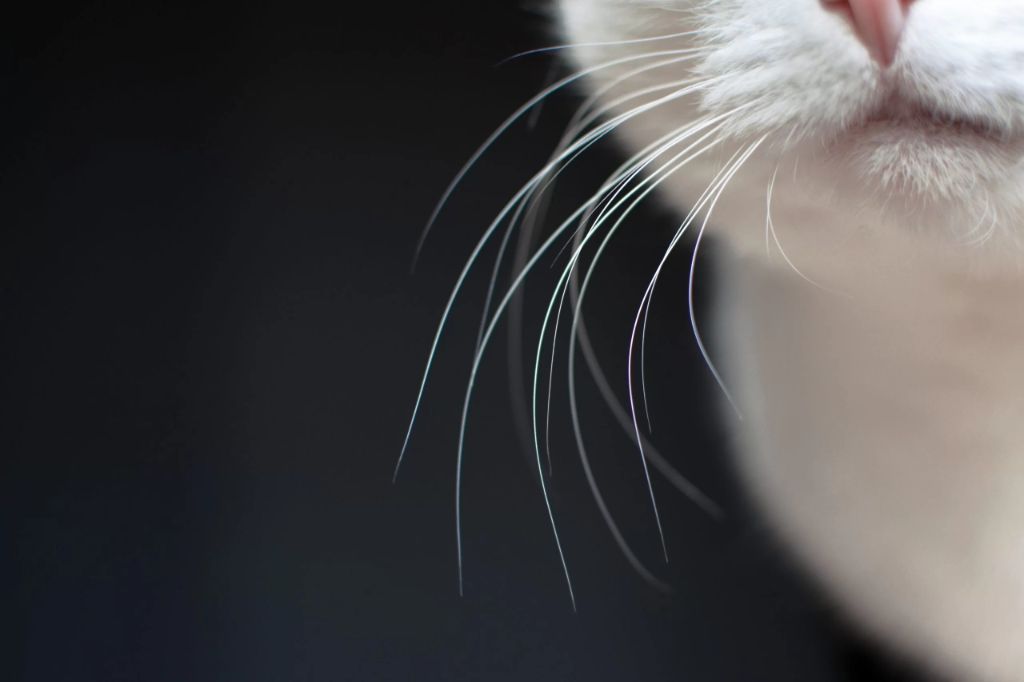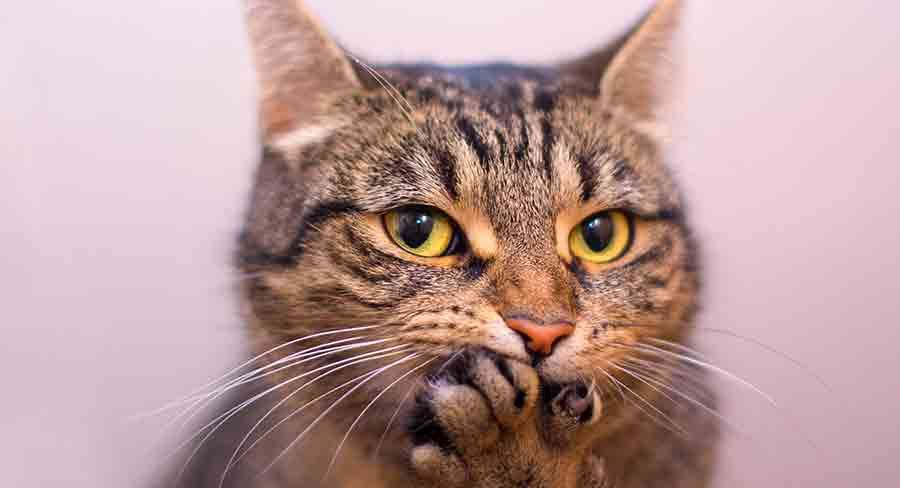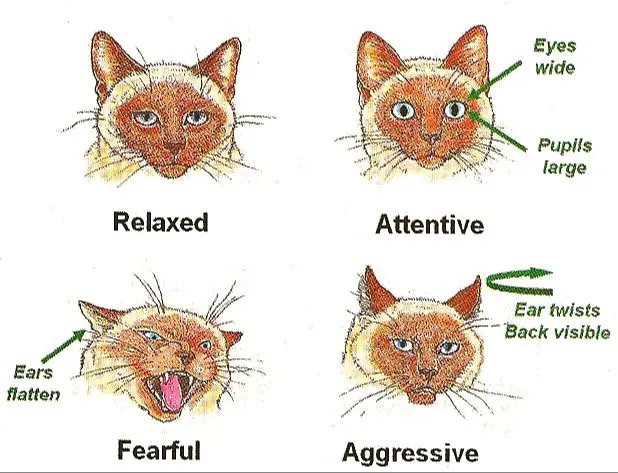Cat whiskers, also known as vibrissae, are specialized hairs that grow in patterns on a cat’s muzzle, above their eyes, and elsewhere on their body. Whiskers serve important sensory functions for cats, acting as tactile feelers that help them navigate their environment and detect movements around them.
A cat’s whiskers are highly sensitive tactile hairs with numerous nerve endings at their base. The whiskers are connected to nerves that send sensory information to a cat’s brainstem, which allows cats to perceive minute changes in air currents and vibrations. This gives cats exceptional spatial awareness and ability to detect prey, avoid obstacles in the dark, and gauge opening sizes.
In addition to their tactical role, cat whiskers also relay emotional information. Whiskers held in a forward or neutral position indicate a calm, content cat, while whiskers pushed back against the face signal irritation or anxiety. Paying attention to whisker positions gives insight into a cat’s mood.
Understanding the importance of cat whiskers can help cat owners properly care for this essential feline feature. Proper whisker hygiene and minimizing whisker stress are key in maintaining a cat’s sensory abilities and supporting their natural behaviors.
Anatomy of Cat Whiskers
A cat’s whiskers are made out of keratin, which is the same protein that makes up human hair and fingernails (Cat Whiskers 101). Keratin is very strong yet flexible, making it ideal for whiskers. The whiskers emerge from follicles that are embedded deeply in the cat’s upper lip. The follicles have blood vessels, nerve endings, and muscles that allow the whiskers to move. Though they may look and feel like regular hairs, whiskers are actually classified as specialized touch receptors called vibrissae.

Whisker Placement
Cats have whiskers in several different areas on their face and body. The longest whiskers are called mystacial whiskers and are located on either side of a cat’s muzzle, with 12 whiskers on each side arranged in rows of 4. Cats can move these whiskers independently to help gauge distances. There are also 4 to 8 whiskers located above each eye called superciliary whiskers that help protect the eyes. Finally, cats have around 16 genal whiskers on their cheeks and interramal whiskers on their chin to detect objects below their head https://www.treehugger.com/things-you-didnt-know-about-cat-whiskers-4864051.
Whiskers are also found on other parts of a cat’s body, including their wrists, ankles, knees, and elbows. These whiskers, called carpal whiskers, help cats become aware of their body position and provide information about their immediate surroundings as they navigate tight spaces.
Whisker Length
Cat whiskers vary in length depending on their position on the cat’s face. The longest whiskers are the mystacial whiskers, which are located on either side of the muzzle above the lips. Mystacial whiskers can grow up to 8 inches long. The whiskers above the eyes (superciliary whiskers) are shorter, usually around 2-3 inches long. The shortest whiskers are the genal whiskers on the cheeks, which only grow to about 1 inch long.
Whisker length also varies by breed. For example, Maine Coon cats tend to have longer whiskers than other breeds. Kittens are born with short whiskers that grow longer as they mature. By around 6 months of age, most cats have reached their full adult whisker length.
The varying whisker length allows cats to precisely sense objects in different areas around their face and body. Longer whiskers like the mystacial vibrissae allow cats to gauge distances in front of them, while shorter whiskers provide close-range tactile feedback.
According to Zoetis Petcare, the longest mystacial whiskers extend to about the width of a cat’s body. This strategically allows cats to detect openings and passages they can fit through. Overall, the diverse whisker lengths work together to give cats a detailed 3D map of their surroundings.
Whisker Fluid Motion
Cats have fine muscles that control the movement of each individual whisker, allowing them to move fluidly and independently [1]. These muscles, called the M. nasolabialis profundus and the M. maxillolabialis, connect the whiskers to the nose and upper lip [2]. They allow the cat to twitch its whiskers back and forth to detect objects in its surroundings. The fluid motion also aids cats in determining the precise location, shape, and texture of objects near their face.
Sensory Receptors
Cat whiskers contain many nerve endings and blood vessels within each whisker follicle. According to thebestcatpage.com, the follicles that the whiskers grow from are full of blood vessels and sensory nerves, providing cats with an extremely sensitive tactile organ. The nerves transmit sensory information about touch, air currents, and vibrations to the cat’s brain. So while the whiskers themselves do not have nerves, the base where they emerge from the face contains nerves and blood vessels capable of sensing even the most subtle movements in the air or environment around the cat.
Functions
Cat whiskers serve several important functions related to cats’ spatial awareness, navigation, and hunting abilities. According to PetMD, cat whiskers are highly sensitive tactile hairs that send sensory information to the brain, helping cats determine the precise location of objects around them. This spatial awareness assists with navigation, allowing cats to judge whether they can fit through an opening or squeeze into a tight space.
Whiskers also detect minute changes in air currents, which aids cats during hunting. When prey is moving nearby, cats can sense the disruptions in airflow patterns. Their whiskers even enable cats to track prey movements in the dark. Overall, cat whiskers provide cats with valuable sensory input about their surroundings that facilitates spatial orientation, navigation, and hunting.
Whisker Stress Signals
A cat’s whiskers are highly sensitive and can pick up subtle air currents and vibrations around them. Changes in a cat’s whisker position and movement often signal stress or discomfort. There are a few key whisker stress signals to look out for:

Bunching – When a cat is feeling tense or threatened, they may bunch their whiskers close to their face. This protects the whiskers from damage in case of an attack. According to the ASPCA, tightly bunched whiskers indicate a cat is stressed or fearful.1
Twitching – Rapid twitching or quivering of the whiskers suggests a cat is highly aroused, overstimulated, or feeling hypervigilant. The ASPCA notes twitching whiskers can mean a cat is rattled about something in their environment.1
Pointing Backwards – Whiskers pointing backwards or flattened against the face are a sign of worry, anxiety, or irritation in cats. The Cat Fanciers’ Association states backward pointing whiskers indicate a cat is feeling uneasy about a situation.2
Asymmetry – When a cat’s whiskers are asymmetrical, with some pointed forward and others backward, it signals conflicting emotions. The cat may be feeling both cautious yet curious about their surroundings.
Paying attention to whisker signals provides insight into how comfortable and relaxed a cat is feeling. Any signs of bunching, twitching, flattening, or asymmetry can indicate sources of stress for a cat that should be addressed.
Whisker Maintenance
Cat whiskers naturally shed and regrow over time. The follicles that produce whiskers go through growth cycles where old whiskers will fall out as new ones start to emerge. This shedding and replacement helps keep the whiskers functioning properly.

Cats do not need human assistance with whisker maintenance. Their bodies are designed to handle the shedding and regrowth process on their own. In fact, trimming or cutting a cat’s whiskers is not recommended, as this can disrupt their natural sensory abilities.
While whiskers naturally regrow if shed or trimmed, the new whiskers may not grow back to their original length. Trimming them repeatedly can lead to permanent damage of the follicle. It’s best to allow whiskers to go through their natural growth cycles without interference.
To support natural whisker maintenance, provide a stress-free environment for your cat. Make sure food and water bowls are wide and shallow so your cat’s whiskers don’t bend while eating or drinking. This helps prevent “whisker fatigue” from excessive bending.
Conclusion
Cats’ whiskers, known as vibrissae, serve important sensory and communicative functions for cats. Whiskers contain a rich network of nerves and blood vessels that make them highly sensitive tactile organs. Their placement on a cat’s face allows them to detect objects in the environment and sense air currents.
Whiskers range in length and can move independently to gather information. The sensory input from whiskers gets processed in a cat’s brain to create spatial awareness and enable complex behaviors like hunting. Whiskers also convey a cat’s mood, with wider whisker spreading indicating stress. Proper whisker maintenance through occasional trimming promotes healthy sensations for cats. In summary, a cat’s whiskers provide vital sensory information about their surroundings. Their nerves and mobility allow cats to expertly navigate spaces, detect prey, and communicate their feelings.

